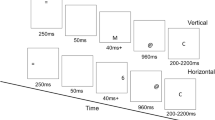Abstract
In this work we address key phenomena observed with classical set shifting tasks as the “Wisconsin Card Sorting Test” or the “Stroop” task: Different types of errors and increased response times reflecting decreased attention. A component of major importance in these tasks is referred to as the “attentional control” thought to be implemented by the prefrontal cortex which acts primarily by an amplification of task relevant information. This mode of operation is illustrated by a neurodynamical model developed for a new kind of set shifting experiment: The Wisconsin-Delayed-Match-to-Sample task combines uninstructed shifts as investigated in Wisconsin-like tasks with a Delayed-Match-to-Sample paradigm. These newly developed WDMS experiments in conjunction with the neurodynamical simulations are able to explain the reason for decreased attention in set shifting experiments as well the different consequences of decreased attention in tasks requiring bivalent yes/no responses compared to tasks requiring multivalent responses.






Similar content being viewed by others
References
Abeles A (1991) Corticonics. Cambridge University Press, New York
Almeida R, Deco G, Stetter M (2004) Modular biased-competition and cooperation: a candidate mechanism for selective working memory. Euro J Neurosci 20:2789–2803
Barceló F, Knight RT (2002) Both random and perseverative errors underlie wcst deficits in prefrontal patients. Neuropsychologia 40:49–356
Braver TS, Barch DM, Cohen JD (1999) Cognition and control in Schizophrenia: a computational model of dopamin and prefrontal function. Biol Psychiatry 46:312–328
Brunel N, Wang X-J (2001) Effects of neuromodulation in a cortical network model of object working memory dominated by recurrent inhibition. J Comput Neurosci 11(1):63–85
Corchs S, Deco G (2002) Large-scale neural model for visual attention: integration of experimental single-cell and fMRI data. Cereb Cortex 12(4):339–348
Deco G, Rolls ET (2003) Attention and working memory: a dynamical model of neural activity in the prefrontal cortex. Eur J Neurosci 18:2374–2390
Deco G, Rolls ET (2005) Synaptic and spiking dynamics underlying reward reversal in the orbitofrontal cortex. Cereb Cortex 15(1):15–30
Deco G, Rolls ET, Horwitz B (2004) What and where in visual working memory: a computational neurodynamical perspective for integrating fMRI and single-neuron data. J Cogn Neurosci 16:683–701
Dehaene S, Changeux J (1991) The Wisconsin Card Sorting Test: theoretical analysis and modeling in a neuronal network. Cereb Cortex 1(1):62–79
Egner T, Hirsch J (2005) Cognitive control mechanisms resolve conflict through cortical amplification of task-relevant information. Nat Neurosci 12:1784–1790
Gilbert SJ, Shallice T (2002) Task switching: a PDP model. Cognit Psychol 44:297–337
Grant DA, Berg E (1948) A behavioral analysis of degree of reinforcement and ease of shifting to new responses in a weigl-type card sorting problem. J Exp Psychol 38:404–411
Hodgkin A, Huxley A (1952) A quantitative description of membrane current and its application to conduction and excitation in nerve. J Physiol (Lond) 117:500–544
Konishi S, Kawazu M, Uchida I, Kikyo H, Asakura I, Miyashita Y (1999) Contribution of working memory to transient activation in human inferior prefrontal cortex during performance of the Wisconsin Card Sorting Test. Cereb Cortex 9 (7):745–753
Meunier C, Segev I (2002) Playing the devils advocate: is the Hodgkin Huxley model useful? Trends Neurosci 25:558–563
Milner B (1963) Effects of different brain lesions on card sorting. Arch Neurol 9:90–100
Monsell S (2003) Task switching. Trends Cogn Sci 7:134–140
Nakahara K, Hayashi T, Konishi S, Miyashita Y (2002) Functional MRI of macaque monkeys performing a cognitive set-shifting task. Science 295(5559):1532–1536
O’Reilly RC, Noelle DC, Braver TS, Cohen JD (2002) Prefrontal cortex and dynamic categorization tasks: representational organization and neuromodulatory control. Cereb Cortex 12(3):246–257
Rainer G, Miller EK (2002) Timecourse of object-related neural activity in the primate prefrontal cortex during a short-term memory task. Eur J Neurosci 15(7):1244–1244
Rougier NP, Noelle DC, Braver TS, Cohen JD, O’Reilly RC (2005) Prefrontal cortex and flexible cognitive control: rules without symbols. Proc Natl Acad Sci U S A 102:7338–7343
Rougier NP, O’Reilly RC (2002) Learning representations in a gated prefrontal cortex model of dynamic task switching. Cogn Sci 26:503–520
Stemme A (2007) Neuronal principles underlying cognitive flexibility—a biophysical model for set shifting tasks. Ph.D. thesis, Technical University Munich. Published by Book On Demand GmbH, Norderstedt, Germany
Stemme A, Deco G, Busch A, Schneider WX (2005) Neurons and the synaptic basis of the fMRI signal associated with cognitive flexibility. NeuroImage 26/2:454–470
Stemme A, Deco G, Busch A (2007) The neuronal dynamics underlying cognitive flexibility in set shifting tasks. J Comput Neurosci. doi: 10.1007/s10827-007-0034-x
Stroop JR (1935) Studies of interference in serial verbal reactions. J Exp Psychol 18:643–662
Stuss DT, Floden D, Alexander MP, Levine B, Katz D (2001) Stroop performance in focal lesion patients: dissociation of processes and frontal lobe lesion location. Neuropsychologia 39:771–786
Stuss DT, Levine B, Alexander MP, Hong J, Palumbo C, Hamer L, Murphy KJ, Izukawa D (2000) Wisconsin Card Sorting Test performance in patients with focal frontal and posterior brain damage: effects of lesion location and test structure on separable cognitive processes. Neuropsychologia 38:388–402
Wallis JD, Anderson KC, Miller EK (2001) Single neurons in prefrontal cortex encode abstract rules. Nature 411:953–956
White IM, Wise SP (1999) Research article: rule-dependent neuronal activity in the prefrontal cortex. Exp Brain Res 126(3):315–335
Wilson F, Scalaidhe SP, Goldman-Rakic PS (1994) Functional synergism between putative-aminobutyrate-containing neurons and pyramidal neurons in prefrontal cortex. Proc Natl Acad Sci U S A 91:4009–4013
Wong KF, Wang XJ (2006) A recurrent network mechanism of time integration in perceptual decisions. J Neurosci 26(4):1314–1328
Acknowledgments
This work was supported by the ‘Deutsche Forschungsgemeinschaft’ (DFG), Project Number FOR 480/1-1. Very special thanks are directed to Werner X. Schneider, University of Munich, Department Psychology for valuable discussion and advise.
Author information
Authors and Affiliations
Corresponding author
Electronic supplementary material
Below is the link to the electronic supplementary material.
Rights and permissions
About this article
Cite this article
Stemme, A., Deco, G. & Busch, A. The neurodynamics underlying attentional control in set shifting tasks. Cogn Neurodyn 1, 249–259 (2007). https://doi.org/10.1007/s11571-007-9019-8
Received:
Accepted:
Published:
Issue Date:
DOI: https://doi.org/10.1007/s11571-007-9019-8




